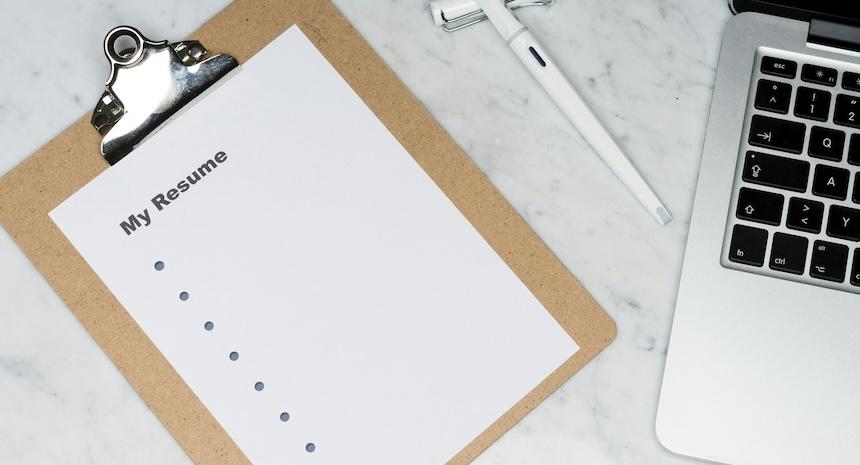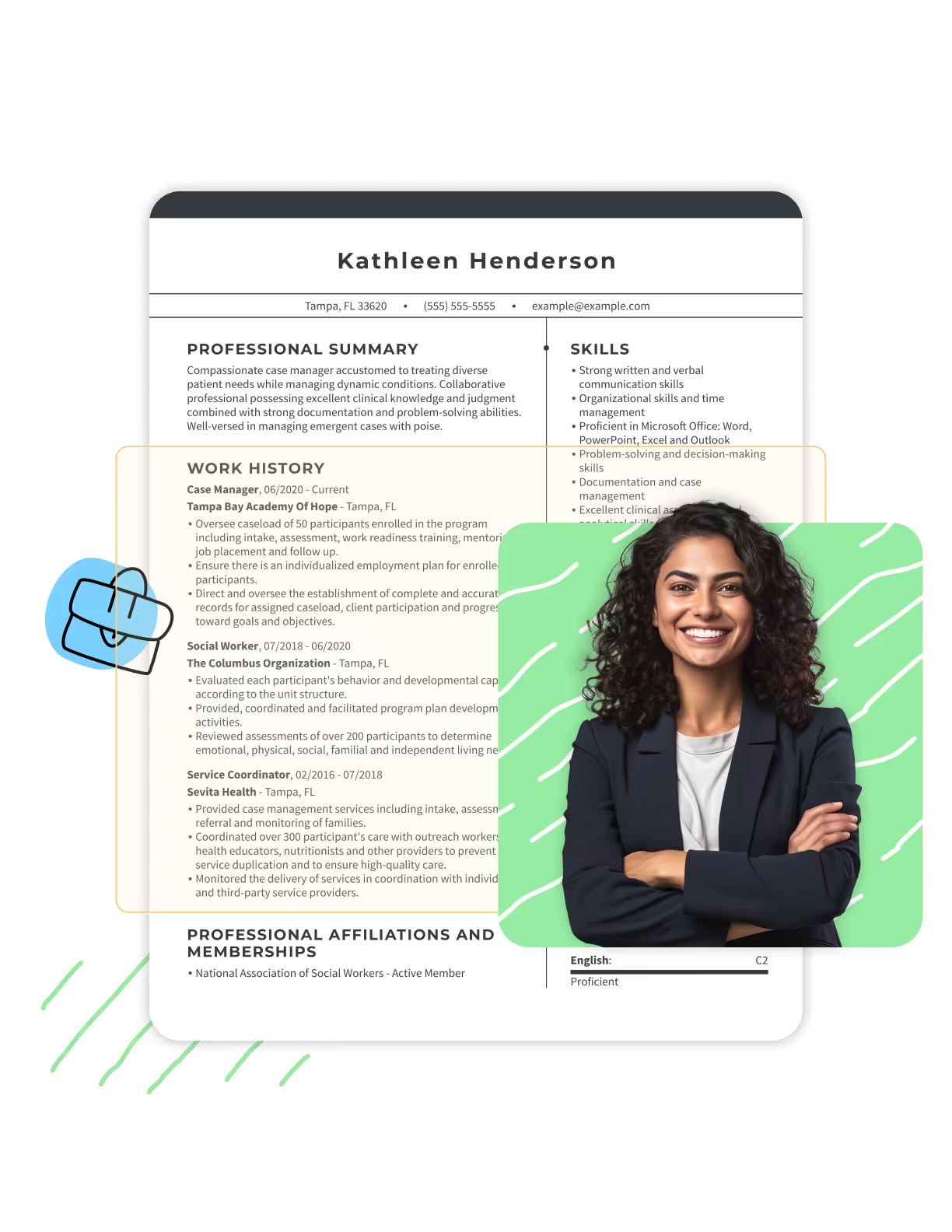Whether you’re writing a resume for the first time or simply updating it for 2025, you might wonder what a resume should look like to capture attention in a fast-paced and competitive job market.
Are you including the right sections? Is your design appropriate for your industry? We’ve all had these questions from time to time.
You’ve come to the right place. Our guide will give you a sense of what a resume should look like so you can start creating your own impressive resume.
Here’s what a great resume looks like in 2025:
Need help with your resume? Try our Resume Builder. Just type in your job title and get ready-to-use text for every part of your resume.
Related Guides & Tips
Browse other popular samples
Use Simple Designs and Fonts
You never want the look of your resume to get in the way of its content. That’s why ensuring that your resume uses an organized layout is an important first step.
Use a clean, simple layout so the hiring manager can instantly see your skills and experiences. A minimalist approach will make your qualifications the focal point.
Meanwhile, opt for a good, readable resume font. We recommend choosing a classic, professional font like Arial, Calibri or Times New Roman and avoiding any that are overly decorative or difficult to read.
There’s no rule that says you can’t branch out, but your font choice should be industry-appropriate. For most industries, that means sticking to the standard choices. Creative industries, like interior design or photography, might welcome more unique fonts. When in doubt, keep it simple and professional.
Pro tip: Looking for more ways to improve your resume? Check out our resume design ideas. They’ll help you find creative yet practical ways to present your information.
Maintain a Consistent Layout
Ensure your resume has evenly set margins and consistent line spacing for a polished look. Clear section headings are also crucial for easy navigation.
How do you guarantee consistency? There are different types of resume templates that can help you maintain consistency without losing its style. Here are a few examples:
- Simple resume templates: These templates offer a clean, minimalist design, focusing on clear formatting and readability. They’re ideal for professions where concision is valued, such as in business, engineering and nursing.
- Modern resume templates: Modern templates blend sleek, contemporary aesthetics with professional layouts.These templates suit roles in occupations that value innovation, like marketing, information technology and biotech.
- Creative resume templates: Creative templates allow for more artistic expressions, using unique fonts, vibrant colors and unconventional layouts. They are best suited for industries where creativity is at the forefront, such as in the arts, graphic design and fashion.
Optimize White Space
Balance the text with enough white space to make your resume more readable and visually appealing. To optimize your resume’s white space, keep these tips in mind:
- Set balanced margins: Start by setting your margins to a standard size, typically around 1 inch on all sides. This creates a clean frame for your text without crowding the page edges.
- Keep adequate spacing between sections: Ensure there’s sufficient space between different sections of your resume, like between your header and professional summary, and between your work experience and education sections.
- Avoid dense blocks of text: Large paragraphs can be overwhelming. Break them up into shorter, more manageable sections. This approach is particularly useful in your professional summary and job descriptions.
- Consider a two-column design: If you have a lot of information to include, a two-column layout can be an effective way to use space efficiently. This layout can help balance white space while fitting in more content.
All of the above should help you format your resume in a way that’s well-organized and easy on the eyes.
Ultimately, if your resume still feels cramped, consider adding a second page or cutting the least relevant information. Two pages is an acceptable length for experienced candidates, but your resume should never take up more than two pages.
Pro tip: You should reduce or eliminate any nonessential elements that clutter your resume, such as excessive lines, graphics or images.
Incorporate the Right Keywords
You want your resume to look good, of course, but you know what’s even more important? Making sure it gets into the hiring manager’s hands.
Employers use applicant tracking systems (ATS) to screen out applicants who they feel don’t meet the desired qualifications. To bypass this, you’ll need to make an ATS-friendly resume.
How do you do this? First, read the job description closely. Highlight every keyword you find.
Then, insert these keywords throughout your resume to show employers how well you match the role and how deeply you understand their needs, and to give your resume a better chance of passing through ATS.
Here’s a summary for a paralegal with keywords from the job description in bold:
Dedicated paralegal with over four years of experience supporting attorneys in personal injury and corporate law cases. Proficient in legal research, document drafting and case preparation. Demonstrated skill in managing complex legal databases, client communications and trial documentation. Committed to providing thorough and efficient support in fast-paced legal environments.
Not sure if your resume matches the role? Use Resume Now’s free AI Resume Review for AI-powered insights into your resume’s content, structure, and customization.
Next, let’s talk bullet points.
Use Bullet Points for Achievements
Bullet points are another way to help your resume breathe. When you picture what a resume should look like, that image is bound to include plenty of neat and organized bulleted lists.
Most modern resumes include bullet points throughout the document, but this is especially true in the work experience section. Your job history shouldn’t simply list your duties and responsibilities — you should call out your accomplishments using bullet points.
Here’s what the bullet points in a work experience section look like:
- Led a team of 10 sales associates, achieving a 15% overall increase in annual sales.
- Implemented a new inventory management system, reducing operational costs by 20%.
- Organized quarterly training workshops, improving team efficiency and product knowledge.
- Negotiated with over 30 vendors, securing more favorable terms and enhancing profitability.
Pro tip: To make your work experience really come alive, use action words like “spearheaded,” “optimized” and “negotiated.” These simple verbs feel active and inject energy into your resume, highlighting your impact in previous roles.
Keep It Brief
When it comes to resume length, your resume should be no more than one or two pages long.
- Aim for a one-page resume if you have less than 10 years of experience.
- Aim for a two-page resume if your work experience goes back more than 10 years.
Now, if you’re applying for a job in academia, you might need a CV. These documents often run much longer than two pages, and, unlike a resume, they run as long as they need to be, exhaustively listing the candidate’s publications, work history, degrees and education.
Examples of What a Resume Should Look Like
Now that you know the basics, you may want to explore more resume examples. Each one offers a potential look and feel for your resume. Here are a few distinct examples to get you started.
How a resume should look for creative jobs
How a resume should look for tech jobs
How a resume should look for business jobs
Was this information about What Should A Resume Look Like In 2025? [+ Example] helpful? Let us know!
Don is a Certified Professional Resume Writer (CPRW) with more than 10 years’ experience creating digital content, including four years helping job seekers develop their careers. He holds an M.S. in Journalism from Northwestern University.
More resources

Career Gridlock: 60% of Workers Feel Trapped in Jobs They Want to Leave
Resume Now s survey reveals a growing trend in workers feelin...

What Is an Elevator Pitch for an Interview? + Examples
Knowing what an elevator pitch is and how to use one in a job ...

Bullet Points on Resume: Examples & Guide for 2025
Learn how to use bullet points on a resume to highlight key sk...

Engineering Resume: Examples, Templates & Tips for 2025
Build an engineering resume that s bound to impress recruiters...

Stationary Engineer Resume: Examples, Templates & Tips for 2025
Boost your career as a stationary engineer with our expertly c...

Medical Technologist Resume: Examples, Templates & Tips for 2025
Make a medical technologist resume that gets interviews. Use o...

